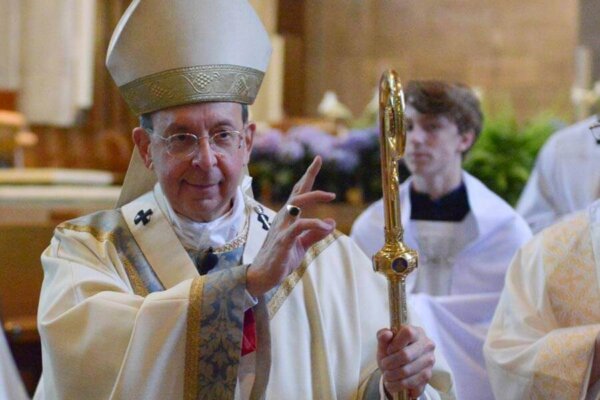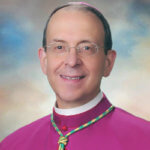Feast of the Presentation of the Lord
Knights of Columbus Board Meeting
Bonita Springs, FL
February 2, 2024
Theo-Drama (with apologies to Hans Urs von Balthasar)
T.S. Elliott, with tongue-in-cheek, once said of his craft as a playwright, “I tried to keep in mind that in a play, from time to time, something should happen.” On this Feast of the Presentation of the Lord in the Temple, something is definitely happening in the most consequential of all dramas, the drama of which God is the creator, the producer, and chief protagonist – the drama which is God’s plan for the creation and redemption of the world, the drama in which you and I are actors, stagehands, and managers. What, then, is happening before our eyes of faith on this great feast day? And what is our part in the unfolding drama of our salvation?
The Hopes and Fears of All the Years
First is the longing of the people of Israel for their Redeemer, summed up in the prophecy of Malachi. The prophet gave voice to the expectation of the Chosen People, not merely that God would send them a messenger, but that the Lord himself would come into the Temple, he, the Lord of hosts. Neither conquest, nor exile, nor the infidelity of its leaders extinguished the hope that God himself would come to shepherd rightly his people.
The deep longing of the people of Israel for God’s presence and deliverance illuminates the deep longing of every person for truth and love, and not just any truth or love, but the pure and infinite truth and love that is God. Israel’s history and experience shines a light on a humanity searching, on a humanity fearful, on a humanity grappling with the powers of sin and death – men and women subject to slavery their whole life long, as Hebrews puts it. Do we not find those deep longings in our hearts? Do we not also struggle with fear, anxiety, and weakness? Malachi and Hebrews set the stage by dramatizing ‘the joy and hope, as also grief and anguish’ of ourselves and our contemporaries.
The Entry of the Incarnate Son of God
With that, the Son of God made man enters the scene. He is carried into the Temple in the arms of his mother Mary, accompanied by Joseph. Embedded in this scene is the truth that this baby is the Son of God, and his humanity is the Temple in which and through which God’s glory will shine as he is transfigured on the mountain, crucified on Calvery, and risen from the tomb.
Mary and Joseph come now to the Temple to offer to God their firstborn, symbolized by a humble sacrifice of “a pair of turtledoves or two young pigeons”. In fact, it is their Divine Child whom they are offering to God, not because their Child stands in need of purification but because we do. The offering made this day foretells the offering Mary will one day make when she stands beneath the Cross, sharing more fully than any other in her Son’s sacrificial gift of self.
In fulfilling what the Law of Moses prescribed, Mary and Joseph usher in the next stage of God’s drama, that stage in salvation history when all that God promised through his prophets comes to fulfillment in his Son. And with the exquisite timing of the Holy Spirit, Simeon enters upon the stage at that precise moment. Often portrayed as an Old Testament priest, Simeon was in fact a layman, a holy man, numbered among the righteous in Israel, those who so earnestly longed for the coming of the Christ. Simeon is an old man, at the end of his years, but young in hope and understanding. For God had promised him that he would not see death until he held in his arms the long-awaited Messiah.
Imagine the depth of feeling as this elderly man takes Jesus in his arms and gazes at his Savior. Imagine the tears of joy welling up from his heart. See the look of wonderment on the faces of Mary and Joseph. Listen to the poetic lines which the Holy Spirit puts on the lips of Simeon: “Now, Master, you let your servant go in peace; your word has been fulfilled. My own eyes have seen the salvation which you prepared in the sight of every people: a light to reveal you to the nations and the glory of your people Israel.” With an economy of words, Simeon sums up the whole drama, that drama authored, directed, and produced by the living God! The child in his arms is the light to the all the nations and the glory of Israel. Thus does Simeon portray what God has done, what God is doing, and what God has yet to do in us and through us as we too become protagonists in the mystery of salvation.
But Simeon does not exit the stage until he has intimated to the Child’s Mother the intense scenes in her life yet to be enacted – her Son’s role as a sign of contradiction that will arouse intense opposition, the laying bare of concealed thoughts, the tragedy of the Cross, and yes, the sword that will pierce her Immaculate Heart.
In a supporting role, there is the widow Anna – 84 years old, we are told – continually fasting and worshipping in the Temple by night and by day. She too enters as if on the Holy Spirit’s cue, thanking and praising God, for her pure faith and enduring hope have attuned her soul to God’s mysterious plan of redemption. Seeing her on stage, we are reminded of those on whose prayers we depend.
Our Role in this Drama
What then is our role in the unfolding drama of our salvation? Is it not summed up in the opening lines of this dramatic liturgy, “Almighty ever-living God, we humbly implore your majesty, that just as your Only Begotten Son was presented on this day in the Temple in the substance of our flesh, so by your grace, may we be presented to you with minds made pure.”
This morning, as we continue in the celebration of this Sacred Eucharist, even with all of the subtexts and subplots of our lives, let us ask for the grace to offer ourselves to God, together with the bread and wine that will become the Body and Blood of Christ. We are to offer, not only what we have, and not merely what we do, but above all, who we are, namely, our humanity. Let us ask that it be purified of sin and the effects of sin, and that our unique and unrepeatable version of common human nature be inserted daily into the drama of salvation. Let us ask to participate in God’s great dramatic production, sometimes as actors, sometimes stage managers, sometimes stagehands, but always as protagonists, and never as mere observers or as those loitering outside the theatre. May God bless us and keep us always in his love!


